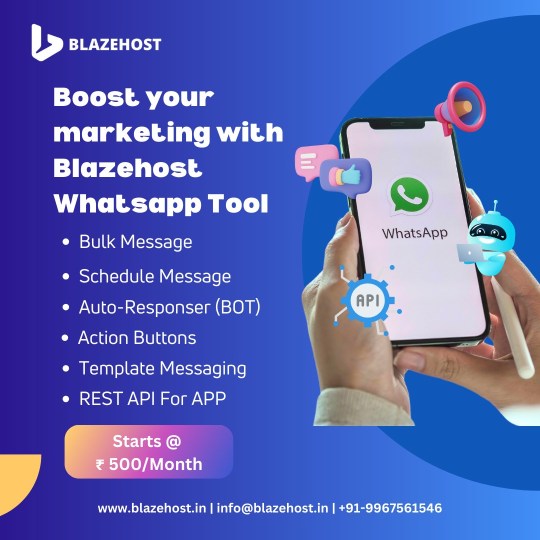#cloud server providers in india
Explore tagged Tumblr posts
Text
Exploring the Benefits of Cloud VPS Hosting
Introduction
In this article, we will provide you with a comprehensive overview of Cloud VPS and the numerous benefits it offers. From scalability and reliability to cost-effectiveness and performance, cloud server price in india is the ultimate solution for your hosting needs.
Step 1: Scalability
Cloud VPS allows you to easily adjust your resources based on demand, ensuring that you always have the right amount of power to support your website or application. Compared to traditional hosting, scaling with Cloud VPS is not only seamless but also cost-effective.
Step 2: Reliability and Uptime
With redundant infrastructure and automatic failover, Cloud VPS guarantees high availability and minimal downtime. Your data is also replicated to ensure maximum reliability, giving you peace of mind knowing that your website is always up and running.
Step 3: Cost-Effectiveness
The pay-as-you-go pricing model of Cloud VPS means you only pay for what you use, with no upfront hardware costs. This flexibility allows you to scale your resources up or down based on your budget and needs, making Cloud VPS a cost-effective solution for any business.

Step 4: Performance
Dedicated resources, virtualization technology, high-speed networks, and SSD storage options all contribute to the superior performance of Cloud VPS. Your website or application will run smoothly and efficiently, providing an optimal user experience for your visitors.
Step 5: Security
Cloud VPS provides an isolated environment for each virtual server, ensuring the security of your data. With secure data centres, network infrastructure, and built-in security features, you can rest assured that your information is safe and protected. Additionally, Cloud VPS offers options for additional security measures for added peace of mind.
Step 6: Flexibility and Customization.
Customize your server configurations, choose your operating systems and software, and easily integrate with third-party services and applications with Cloud VPS. This level of flexibility and customization allows you to tailor your hosting environment to meet your specific needs and requirements.
Step 7: Management and Control
User-friendly control panels, root/administrator permissions, and monitoring tools and alerts make managing your cloud hosting price in india a breeze. Stay in control of your hosting environment and proactively manage your resources with ease.
Conclusion
In conclusion, Cloud VPS offers a multitude of benefits that make it the ideal hosting solution for businesses of all sizes. Consider Cloud VPS for your hosting needs and experience the scalability, reliability, cost-effectiveness, performance, security, flexibility, and control it provides. Act today and elevate your hosting experience with Cloud VPS.
#cloud hosting price in india#cloud server providers in india#cloud server price in india#cloud server cost in india
0 notes
Text
Zebyte Cloud, a premium website hosting company in India, offers dedicated web server hosting, cloud service provider in India, cloud server solutions, cloud server platform, cloud solutions, cloud management, email hosting services, data center services, managed IT services in India with 24 hours technical support
#Best Web Hosting Company#cloud service provider in India#premium website hosting company in India#dedicated web server hosting#cloud server solutions#cloud server platform#cloud solutions#cloud management#email hosting services#data center services#managed IT services in India#Cloud services#domain hosting package#web hosting services#hosting plans in India#Buy web hosting plans#buying web hosting plans#buy web hosting#web hosting services in India#flexible hosting plans#domain registration#web hosting plan#Cloud’s hosting plans in India#website hosting plans#web hosting service provider#Web Hosting India provider#Cloud Web Hosting Services#Cloud Web Domain Services
4 notes
·
View notes
Text
ZeaCloud Private Cloud – Scalable, Secure Cloud Infrastructure in India
ZeaCloud Private Cloud offers a secure, fully managed Infrastructure-as-a-Service (IaaS) designed for enterprises that need full control, data privacy, and high performance. Built on dedicated infrastructure, it ensures 99.9% uptime, enterprise-grade security, and seamless scalability. Ideal for businesses in finance, healthcare, and IT, ZeaCloud empowers digital transformation with customizable, compliant cloud solutions supported 24/7. for more detail, visit: ZeaCloud-Private Cloud
#best server solution provider in delhi ncr#private cloud#IaaS India#secure cloud hosting#enterprise cloud services#Zeacloud#best cloud computing service provider#server solution provider
0 notes
Text

https://hostnetindia.com/tally-cloud-server
#tally cloud server#best tally servers#cheap tally cloud server in India#best Tally cloud server provider in India
0 notes
Text
Easy ERP Hosting with Hosting Home

Choose Hosting Home for simple and reliable ERP hosting. Enjoy fast performance, dependable uptime, and supportive service to keep your system running smoothly.
#erp server#erp#erp software#erp system#erp tools#cloud erp#erps#erp web#erp hosting#erp hosting service#hosted erp solutions#hosting erp#erp hosting companies#erp hosting india#erp hosting price#erp hosting providers#erp server hosting#hosting erp systems#hosting for erp#hosting open erp#sap erp server#erp server cost
0 notes
Text
Web Hosting Company In India
The digital landscape in India is booming! More and more individuals and businesses are recognizing the power of having a strong online presence. But before you dive headfirst into website creation, there's a crucial first step: selecting the right web hosting company in India.
Web hosting companies in India act as the foundation for your website. They provide the storage space and infrastructure needed for your website to be accessible on the internet. Choosing the right one can significantly impact your website's performance, security, and overall user experience.
Why Partnering with a Reputable Web Hosting Company in India is Essential
Here are some compelling reasons to prioritize finding the right web hosting company in India:
Speed and Performance: Indian internet users expect fast loading times. A reliable web hosting company in India equips your website with robust servers, ensuring lightning-fast speeds and a smooth user experience. This is especially important for e-commerce websites where slow loading times can lead to lost sales.
Security and Reliability: In today's digital world, website security is paramount. A reputable web hosting company in India provides advanced security measures to protect your website from malware, hacking attempts, and data breaches. This gives you peace of mind knowing your website and visitor information are safeguarded.
Technical Support: Building and maintaining a website can involve technical challenges. A good web hosting company in India offers reliable customer support, readily available to assist you with any technical issues that may arise. This ensures you have a helping hand whenever needed.
Scalability and Growth: As your website grows in popularity and content, your hosting needs will evolve. The right web hosting company in India provides scalable solutions to accommodate this growth. They offer various hosting plans that can adapt to your website's increasing traffic and data storage requirements.
Choosing the Perfect Fit
Web hosting companies in India offer a variety of plans catering to different needs and budgets. Consider factors like website size, expected traffic volume, and desired features when making your selection. Don't hesitate to research and compare plans before making your decision.
Investing in a Reliable Web Hosting Company in India is an Investment in Your SuccessBy choosing a reputable web hosting company in India, you lay a solid foundation for your online presence. With a secure, fast-performing website, you'll be well-equipped to attract visitors, build trust, and achieve your online goals. So, take the time to research, compare options, and find the perfect web hosting partner to empower your journey in the ever-evolving digital world of India.
#Web Hosting Company In India#Web hosting India#Hosting services#Indian hosting providers#Server hosting#Cloud hosting India
0 notes
Text

Power Up Your Website: Top Web Hosting India Options for Every Need
Building a website is an exciting step, but before you unleash your creativity to the digital world, you need a solid foundation – web hosting. Here in India, there's a plethora of Web Hosting India services vying for your attention. But with so many Indian hosting providers, how do you choose the right one?
Don't worry, this blog is your guide to navigating the world of Web Hosting India. We'll explore what web hosting is, the different types offered by Indian hosting providers, and some key factors to consider when making your choice.
What is Web Hosting India?
Web hosting is a service provided by companies like those offering Web Hosting India. They essentially rent out space on their servers to store your website's data (text, images, code) and make it accessible to visitors through the internet.
Types of Web Hosting India Services:
There are various Web Hosting India options available, each catering to different needs:
Shared Hosting: A cost-effective option where your website shares server space with other websites. Ideal for personal websites or small businesses with low traffic.
VPS Hosting (Virtual Private Server): Offers more control and resources than shared hosting, suitable for growing websites with moderate traffic. Think of it as having a dedicated apartment within a larger building.
Cloud Hosting: Leverages the power of multiple servers, providing scalability and high uptime for websites with fluctuating traffic or demanding applications. Imagine having access to a whole network of buildings for your website's needs.
Dedicated Hosting: The most powerful option, offering complete control and dedicated server resources. Perfect for high-traffic websites requiring maximum performance and security. Like having your own private mansion for your website!
Choosing the Right Web Hosting India Provider:
With a diverse range of Indian hosting providers, consider these factors when making your decision:
Features: Does the provider offer the features you need, like email hosting, website builders, or application support?
Uptime: Look for providers with a high uptime guarantee, ensuring your website is accessible to visitors most of the time.
Customer Support: Reliable and responsive customer support is crucial for any technical difficulties you might face.
Pricing: Compare pricing plans and features across different Web Hosting India providers to find the best value for your budget.
Taking Your Website Live with Web Hosting IndiaBy understanding your website's needs and comparing the various offerings of Web Hosting India providers, you can find the perfect platform to launch your online presence. So, explore the options, make an informed decision, and get ready to showcase your website to the world!
#Web Hosting Company In India#Web hosting India#Hosting services#Indian hosting providers#Server hosting#Cloud hosting India
0 notes
Text
#cloud server hosting india#cloud server#cloud server providers#cloud server hostings#cloud server services
1 note
·
View note
Text
Top Web Hosting Companies in India 2025

According to the data, around 1.3 billion people are predicted to access the internet in 2025 via smartphone or PC. This means that almost every second individual has access to the internet. Hence, many businesses utilize this medium to run their online businesses. To store data and files, all websites have to be hosted to be accessible on the internet by the web hosting server. With the involvement of web hosting providers in India, you can get a reliable server. Through this blog, we have gathered information about the top web hosting companies in India and their premium features.
Best Web Hosting Companies in India 2025
Here is the list of the top 5 web hosting companies in India so you can make the right decision:
1.Namecheap:
Renowned as the leading web hosting company in India, Namecheap is well-known for its reliable and budget-friendly web hosting service in India for any size of business. Considering the different requirements of different companies, this web hosting provider has a wide range of hosting plans that meet every company’s requirements.
Prime Features:
Easy-to-use
Budget-friendly security
Scalable
2.Hostinger India:
Hostinger India is a trusted web hosting company that has gained remarkable popularity recently among startups and small businesses. With the utilization of the amazing services of this web host, you will get access to a free domain name “WHOIS protection”. Also, using this web host, you will get complete protection for your website to secure it from several cyber threats. This is the perfect solution for those businesses who have a small budget.
Key Features:
Affordable
Beginner-friendly setup
High performance
3. Miles Web:
Recognized as one of the best web hosting companies in India, Miles Web has been delivering premium services for the past 12 years. With a client base of more than 50,000, this company has a wide range of offers, including shared, VPS, dedicated, and cloud hosting. Regardless of your business size, this company caters to all websites of different sizes.
Main Features:
Data centers all over the world
Best security services
Incredible reliability
24/7 customer support
Pocket-friendly options
Freebies to get you started
4. A2 Hosting:
A2 Hosting is well-known for its fast shared hosting plans. The options available by this web hosting company are cPanel hosting, VPS hosting, and many more. With this affordable web hosting service, you can get a wide range of web hosting plans that can cater to businesses of all sizes. The data centers of this company are located in the EU, the US, and regions of Asia.
Key Features:
Turbocharge your website
Free migration of websites
Exclusive customer support named ��Guru”
5.GoDaddy:
Based in the US, GoDaddy is a well-established web hosting company that is one of the prominent market players in India. Established in the 90s in the United States, this company has built a strong client base all over the world. With its user-friendly platform and comprehensive tools, clients can easily set up and manage their websites with this web hosting company.
Prime Features:
Outstanding customer support 24/7
Domain registration services
Website Builder
Enhance performance and improve accessibility
These are a few web hosting providers in India that can help you create and manage your websites easily.
2 notes
·
View notes
Text
"Affordable Cloud Hosting in India: Why NetForChoice Stands Out"
In the rapidly evolving digital era, cloud hosting has become the backbone of businesses worldwide. Companies are moving away from traditional hosting solutions to embrace the flexibility, scalability, and affordability that cloud hosting provides. In India, NetForChoice has established itself as a leading name among managed cloud hosting providers, offering world-class services tailored to meet diverse business requirements.
This blog explores why NetForChoice stands out as a premier provider of managed cloud hosting solutions in India, focusing on their innovative features, support services, and hosting options like cPanel hosting and Plesk hosting for Linux and Windows environments.
What Makes Managed Cloud Hosting Essential?
Managed cloud hosting is a service where the hosting provider handles server management, maintenance, security, and support, allowing businesses to focus on growth. For enterprises, it ensures operational efficiency, enhanced security, and optimal server performance. With top managed cloud hosting providers like NetForChoice, businesses gain access to enterprise-grade solutions that deliver high availability, data protection, and scalability.
Why NetForChoice Stands Out
NetForChoice is more than just a cloud hosting provider; it’s a trusted partner for businesses aiming to achieve IT excellence. Here are key aspects that make NetForChoice a leading name among managed cloud service providers in India:
1. Comprehensive Hosting Plans
NetForChoice offers a wide range of hosting solutions, including:
cPanel Hosting India: Perfect for businesses looking for an intuitive interface to manage websites and email accounts. Their best cPanel hosting in India provides robust tools for effortless management, even for users with minimal technical expertise.
Plesk Hosting Providers: NetForChoice also excels in Plesk web hosting, which offers unparalleled flexibility and control for both Linux and Windows environments.
Linux Hosting with cPanel: For developers and businesses seeking secure, reliable hosting, NetForChoice’s Linux hosting with cPanel combines the power of Linux with an easy-to-use dashboard.
Plesk Windows Hosting and Plesk Linux Hosting: Ideal for businesses needing a sophisticated control panel to manage their hosting environment, whether it’s Windows or Linux-based.
2. Tailored CRM Hosting Solutions
NetForChoice also shines as a leading provider of CRM hosting solutions. By offering cloud-hosted CRM providers like Salesforce, Zoho, or HubSpot, the company ensures that businesses can efficiently manage customer relationships in a highly secure and scalable environment. Their CRM cloud hosting services are optimized for speed, reliability, and seamless integration, helping businesses boost productivity and customer satisfaction.
Key Features of NetForChoice Cloud Hosting
1. State-of-the-Art Infrastructure
NetForChoice operates from Tier-3 and Tier-4 data centers across India, ensuring unmatched reliability and availability. These facilities are designed to deliver a guaranteed uptime of 99.995%, minimizing the risk of downtime for businesses.
2. High Performance with SSD Storage
To ensure fast website loading times and improved application performance, NetForChoice provides SSD storage in their hosting plans. Whether you choose cPanel hosting India or Plesk hosting, you can trust their robust infrastructure for consistent high performance.
3. Fully Managed Services
As a leading managed cloud service provider in India, NetForChoice offers fully managed hosting. Their expert team takes care of server updates, security patches, and performance monitoring, freeing businesses from the complexities of server management.
4. Scalability and Affordability
NetForChoice allows businesses to scale their hosting resources as needed. This flexibility, combined with competitive pricing, makes them a go-to choice for companies looking for cost-effective cloud hosting solutions.
cPanel Hosting with NetForChoice
For businesses prioritizing ease of use, cPanel hosting providers like NetForChoice are a game-changer. Here’s why their cPanel hosting India is among the best:
User-Friendly Interface: cPanel provides a graphical interface to manage web hosting tasks like domain management, email configuration, and database handling.
One-Click Installations: Users can easily install applications like WordPress, Joomla, and Magento using Softaculous.
Enhanced Security: NetForChoice integrates advanced firewalls, malware scanners, and regular updates to ensure a secure hosting environment.
Perfect for Beginners: Even users with minimal technical skills can navigate and manage their websites effectively.
Plesk Hosting with NetForChoice
NetForChoice also excels as one of the leading Plesk hosting providers, catering to both Linux and Windows environments.
Comprehensive Dashboard: The Plesk interface is clean, organized, and intuitive, providing granular control over hosting operations.
Multi-Platform Compatibility: Businesses can choose between Plesk Windows Hosting or Plesk Linux Hosting, depending on their application requirements.
Built-In Tools: Plesk offers features like Docker support, Git integration, and WordPress toolkit, making it ideal for developers.
Customizable Plans: NetForChoice’s Plesk hosting solutions are tailored to meet the needs of different industries, from SMEs to large enterprises.
Benefits of NetForChoice CRM Hosting Solutions
For businesses seeking cloud-hosted CRM providers, NetForChoice delivers unmatched expertise and reliability:
Scalability: Scale resources up or down based on user requirements.
Enhanced Performance: Optimized hosting ensures CRM applications run seamlessly without interruptions.
Data Security: Advanced encryption, firewalls, and backup mechanisms protect critical customer data.
Integration Support: NetForChoice’s CRM hosting is designed to support seamless integration with other business applications.
Cost-Effectiveness: Affordable plans for CRM cloud hosting help businesses minimize IT expenses while maximizing ROI.
24/7 Dedicated Support
One of the standout features of NetForChoice is its exceptional customer support. Their team of certified professionals is available 24/7 to address technical issues, ensuring uninterrupted operations. Whether you need help with Plesk hosting, cPanel hosting, or managed cloud hosting, the NetForChoice support team is just a call or chat away.
Use Cases Across Industries
NetForChoice’s versatile hosting solutions cater to various industries, including:
E-commerce: High-speed hosting with advanced security for online stores.
Healthcare: Secure hosting solutions that comply with data protection regulations.
Finance: Reliable hosting for financial applications and CRM platforms.
Education: Cost-effective solutions for e-learning platforms.
Why Businesses Choose NetForChoice
1. Competitive Pricing
NetForChoice offers some of the most affordable plans in the market without compromising on performance. Their transparent pricing and flexible subscription options make them a top choice for businesses.
2. Enterprise-Grade Security
With features like SSL certificates, DDoS protection, and advanced monitoring, NetForChoice ensures that your data remains safe from cyber threats.
3. Unparalleled Expertise
With over 30,000 satisfied customers and a track record of delivering over 35 million server deployments, NetForChoice has the experience and expertise to meet any hosting challenge.
Conclusion
For businesses in India looking for reliable, scalable, and affordable hosting solutions, NetForChoice is the go-to provider. With their robust managed cloud hosting, cPanel hosting, and Plesk hosting options, they cater to diverse needs while maintaining top-notch performance and security. Additionally, their expertise in CRM cloud hosting makes them a valuable partner for businesses aiming to enhance customer relationship management.
Choose NetForChoice today and experience the difference that a trusted managed cloud hosting provider can make for your business. Whether you’re just starting or scaling operations, NetForChoice is equipped to help you achieve your goals seamlessly.

2 notes
·
View notes
Text
Searching for reliable cloud hosting in India? Select from top-tier providers offering versatile hosting plans suitable for all business sizes. With features like lightning-fast servers, 99.9% uptime, robust data security, and seamless resource scalability, these providers ensure optimal performance for your websites and applications.
2 notes
·
View notes
Text

Windows Cloud Server Hosting India | VNA Hosting
Experience the future of hosting with VNA Hosting's Windows Cloud Servers. Our India-based servers provide unparalleled performance, flexibility, and security for your business-critical applications.
2 notes
·
View notes
Text
Cloud Hosting India
Reliable Cloud Hosting in India with secure, scalable & high-speed servers. Boost performance with 99.9% uptime & 24/7 support. Perfect for businesses & startups. Get cost-effective hosting today
#best cloud hosting in india#best cloud server provider in India#cloud hosting india#cheap cloud server in india
0 notes
Text

Elevate Your Website with Hosting Home’s Dedicated Server
Hosting Home offers secure and high-performance dedicated servers for seamless image submissions. Optimize your site with our reliable hosting solutions.
#dedicated server#dedicated server hosting#dedicated server hosting in India#dedicated server India#cheap dedicated server#dedicated cloud server#best dedicated server#buy dedicated server#buy dedicated server hosting#cheap dedicated server hosting#cheap dedicated server India#best dedicated server hosting providers
1 note
·
View note
Text

Cloud hosting India
#Web Hosting Company In India#Web hosting India#Hosting services#Indian hosting providers#Server hosting#Cloud hosting India
0 notes
Text
India's Best Cloud Hosting Provider | Silver Cloud
Silver Cloud Hosting delivers enterprise-grade reliability with a near-perfect 99.9% uptime guarantee. Focus on your business, not your infrastructure. We keep you online 24/7. Don't let downtime cost you customers. Silver Cloud Hosting provides the ultimate peace of mind with reliable, scalable cloud solutions.
2 notes
·
View notes